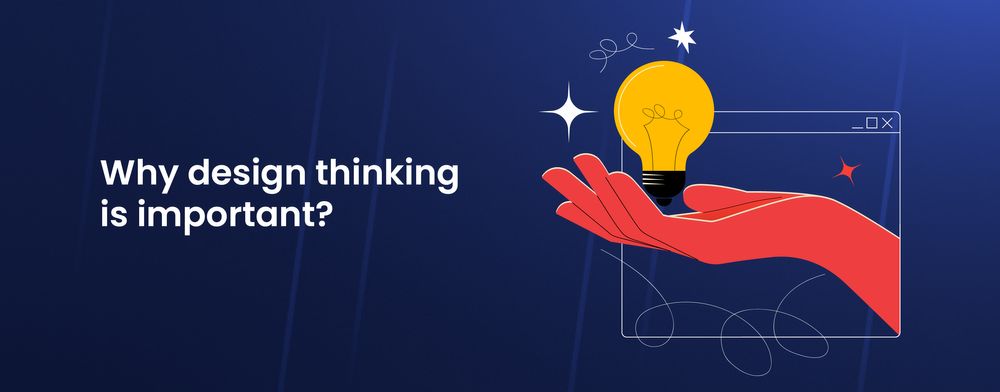Why design thinking is important?
Design thinking is not an exclusive property of designers. Many product owners, artists, scientists, and business strategists have been using this method for an era to come up with solutions. But to find a solution, one needs to have some solid problems.
Professionals found a lot of loopholes in the traditional waterfall methods of problem-solving. Design thinking came to be because big corporations cannot be creative and in extreme cases, aren’t able to create new products and services that meet the unmet needs of their customers.
Some of the world’s leading brands, such as Apple, Google and Samsung, rapidly adopted the design thinking approach, and leading universities around the world teach the related methodology — including Stanford, Harvard, Imperial College London and the Srishti Institute in India. Let’s see what design thinking is and how it could be helpful for creatively solving problems.
What is design thinking?
“Design thinking is a human-centred approach to innovation that draws from the designer’s toolkit to integrate the needs of people, the possibilities of technology, and the requirements for business success.” - Tim Brown (CEO of IDEO)
Design thinking is a practical, creative problem-solving method. This ideology comprises different processes. All the sub-processes in design thinking ideology are evolved from a range of different fields including architecture, engineering and business. This is not a design-specific process. It could be followed in any aspect which is trying to solve a problem.
Design thinking shifts the focus from a business-centric engineering solution to a user-centric solution. Design thinking is an extremely user-centric process which means solutions are discovered keeping end-users in the centre. We’re building a product for our end users so understanding and empathizing with our end users is extremely crucial while designing for any product or service.
Design thinking approach
Design thinking is an iterative process in which you understand your users, challenge assumptions, redefine problems and create innovative solutions which you can prototype and test. It’s important to note that design thinking is not a defined linear path. Design thinking is an iterative process. Five stages in design thinking are :
- Empathize
- Define
- Ideate
- Prototype
- Test
Empathize
At this stage in the design thinking methodology, designers sit down with real people and absorb their points of view, world, and introspections without bias. Designers will be able to make the designs for their target audience only when they know them, their behaviours and how they’ll react in certain situations which could be helpful to designers to frame design strategy.
Designers follow certain sets of activities to empathize with their target audience which includes:
- User interviews
- Stakeholder mapping
- Surveys
- Data analysis
- Competitor analysis
- Context mapping
Define
After empathizing, a designer integrates their researched understanding into the human-centric issue at hand and outlines the problem statement. In this stage, designers will analyze their observations completed throughout the empathy stage, and work on synthesizing that information. You can create personas to help keep your efforts human-centred before proceeding to ideation.
Designers follow certain sets of activities in the Define stage of design thinking.
- Personas
- Empathy map
- User journey map
- User stories
- Problem statement
- Hypothesis statement
- Task analysis
Ideate
One of the most important jobs of a designer is to come up with new and innovative solutions to user problems. How can designers keep generating innovative ideas? The answer is in the design thinking ideation process. Ideation is a creative process where designers generate ideas according to the data they’ve collected during empathize and define stages. It marks the transition between understanding the problems that users have and generating solutions for these problems.
Designers follow certain sets of activities in the Ideate stage of design thinking.
- Brainstorming sessions
- Mindmaps
- Storyboards
- Card sorting
- User journey
- User flows
- Information architecture
- Crazy 8
- Style guide
- Design systems
Prototype
“If a picture is worth a thousand words, then a prototype is worth a thousand meetings.” – Saying at IDEO
A prototype is the 4th stage of the design thinking process. Put simply, a prototype is a scaled-down version of your product; a simulation or sample version which enables you to test your ideas and designs before investing time and money into actually developing the product. It could be paper - prototypes, low-fidelity, mid-fidelity or high-fidelity prototypes which depends on how many details have to be tested in-depth.
Designers follow certain sets of activities in the Prototype stage of design thinking.
- Paper prototypes
- Micro-interactions
- Wireframes
- High fidelity designs
- Design hands-off
- Design documentation
Test
In this phase, the designer evaluates the product, feature or prototype with an end-user. Testing is important for multiple reasons, the most important being that it allows the design team to see where the product is flawed so that they can address the problem before launching. Identifying these issues early on reduces the energy expended by the team, time and of course, money.
Usertesting involves multiple stages :
- Define a goal for user testing
To perform user tests, the designer should have a goal in mind. If you’re a designer, ask yourself, Why do you want to perform user testing? What do you want to know from users while testing? What do you want to test?
This will define a goal for testing.
- Creating a test plan
Designers need to create a test script. This includes questionnaires to ask users while they go through your designs.
- Recruiting participants
This phase could be as tricky as it sounds. Pre-screening questionnaires should be made to make sure the participants we’re recruiting belong to the same niche as we are targeting. This phase could take up a lot of time (depending on the niche). Recruiting the right participants will help designers gain real insights into the designs they created.
- Perform the test and analyze the results
Coming up with real insights and true numbers is considered successful user testing. Mapping out user feedback, prioritizing them as per the business needs, and creating insight matrices comes under an analysis of user testing.
Designers follow certain sets of activities in the Test stage of design thinking.
- Usability testing
- Quantitative surveys
- A/B testing
- Heuristic evaluation
- Eye-tracking & heatmaps
Return on investment on the Design Thinking approach
The synthesized results project a median per-project ROI of 229%, with three-quarters of projects doubling their investment or more. Examined at an organizational level, a mature design thinking practice can achieve an ROI between 71% and 107%, based on a consistent series of inputs and outputs.
Design Thinking Can Deliver An ROI of 85% Or Greater. There are various ways to measure ROI on a feature or product which underwent a design thinking process.
Benefits of having a design thinking approach
- Increased team collaboration
- Highly user-centred design
- Carefully tested and implemented feedback from target audience
- Cost-saving
- Reduced risks
- Actionable output
Conclusion
Immersion in the user experience generates data that is then turned into insights that assist teams in reaching consensus on design criteria they employ to generate solutions. Along the route, design-thinking methods address the difficulties often encountered in arriving at superior solutions, lowered costs and risks, and employee buy-in, counteracting human biases that stifle creativity.
Because it was essential to the success of many well-known, international organizations over the past few decades, the design thinking method has grown in popularity. Today, this unconventional thinking is promoted at all levels of the company and taught at prestigious colleges throughout the globe.




